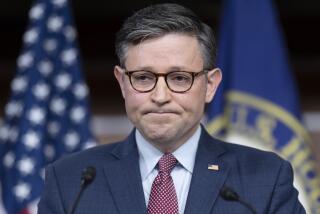Welfare Report Clashes With Clinton, Senate
WASHINGTON — A sweeping welfare reform plan approved by the Senate and embraced by President Clinton would push an estimated 1.1 million children into poverty and make conditions worse for those already under the poverty line, according to a Clinton Administration analysis not released to the public.
The White House received the study, conducted by the Department of Health and Human Services, before Clinton signaled that he would not veto any final welfare measure that looks like the Senate package. Since then, the findings have been carefully guarded by the White House for fear that it would reflect badly on the President, according to sources in the Administration involved in welfare reform.
A copy of the analysis--stamped with the word “draft” and dated Sept. 14--was made available to The Times. It predicts that the Senate measure, which is not as tough as a competing House welfare reform bill, would create new hardships on many children.
The Senate measure, which passed, 87 to 12, with broad bipartisan approval, would end the 60-year federal guarantee of cash assistance to poor mothers with children and give states lump-sum block grants to create their own programs. Federal spending would be frozen for five years, and recipients would be required to work after two years and would be limited to five years of assistance in a lifetime.
“The severity of the impact of [the Senate welfare bill] on poor families exacerbates the deteriorating economic situation for these families,” according to the analysis.
At the first official meeting this week of the joint House-Senate committee that will reconcile difference between the two chambers’ reform packages, Sen. Daniel Patrick Moynihan (D-N.Y.), who opposes the Senate measure, chastised the Administration for refusing to release its analysis, even to Democrats on Capitol Hill.
“HHS has done a report of the Senate bill on the impact on children, but the White House will not release it,” Moynihan said. “Those involved will take this disgrace to their graves. The children alone are innocent.”
Moynihan and other Democratic members of the committee wrote to Alice Rivlin, director of the White House Office of Management and Budget, on Thursday, requesting any relevant analysis of the welfare bills. They said they did so to “meet the President’s objective of ensuring that welfare reform not punish children.” An Administration official said the OMB would reply.
Asked about the analysis obtained by The Times, Administration officials said there was no effort to conceal the assessment. “I do not know of anything that was considered to be in final form that the White House has refused to allow to come out,” said Lawrence Haas, spokesman for the budget office.
*
An Administration official at the Department of Health and Human Services said: “It’s a very preliminary look at some of the policies in the Senate bill.”
The official, who is familiar with the analysis and spoke on condition of anonymity, added that it was completed before final passage of the welfare measure and does not reflect the last amendment, which added money to pay for child care for welfare recipients and increased the number of welfare recipients who can be exempted from the five-year time limit.
Budget analysts said that amendment, however, would alter the findings only marginally.
According to the Administration analysis, in addition to pushing 1.1 million more children into poverty--increasing the poverty rate for children younger than 18 from 14.5% to 16%--the Senate measure would also force harder times on children already living in poverty.
According to the analysis, the extent of the change is reflected in a measurement of the “poverty gap”--the amount necessary to raise people below the poverty line to the poverty line. Under the plan, the gap for the nation’s families with children would increase 25%.
For this study, children were considered poor if their families’ incomes--including the value of food stamps, housing subsidies, school lunches and the earned-income tax credit--were below the poverty line. For a family of three the poverty line is about $12,000 a year.
In recent weeks, senior Administration officials have told The Times that no such analysis existed. On Tuesday, one HHS official acknowledged that the Administration had begun an assessment but interrupted its work to prepare for the conference committee.
Since Clinton began speaking favorably about the Senate welfare reform bill, the White House has been silent about its impact on poor women and children. The Administration had produced detailed analyses of the House measure before and after passage and of the original Senate legislation before it was amended on the floor.
The White House on Monday released a detailed state-by-state report on the impact of the Republican budget cuts on children. That report avoided any mention of the Senate welfare bill.
*
Acceptance of the Senate bill reflects a significant policy shift by the President. Until Republicans took control of Congress, he and his Administration argued that the only way to engineer welfare reform without hurting children was to spend additional money to help their mothers make the transition to work.
The plan Clinton introduced in Congress last year would have continued the 60-year federal guarantee of assistance to all eligible families with children--which the Senate bill would end. It also would have increased welfare spending by about $5 billion over five years to provide child care, training and job placement to help welfare recipients make the transition to work.
The Senate bill, by contrast, would cut welfare spending by $38 billion over five years, compared to current law, according to Congressional Budget Office estimates.
Isabel Sawhill, a welfare specialist who worked extensively on Clinton’s welfare reform plan as the OMB’s associate director for human resources, said the President is in a difficult political position because he campaigned in 1992 on the promise that he would “end welfare as we know it” and recent public opinion polls show that an overwhelming percentage of Americans continue to favor a major overhaul of the welfare system.
“There’s a lot of pressure to produce some kind of welfare reform bill and not to be seen opposing welfare reform in general,” said Sawhill, who left the White House early this year and returned to the Urban Institute, a nonpartisan Washington think tank. “Anybody who said that that is not playing a role would not be accurate.”
Conservative and liberal proponents of welfare reform outside the Administration agreed that politics had clearly fueled the Administration’s decision to accept the Senate GOP blueprint.
“I think they’ve talked themselves into accepting a bill that’s defective by their own standards because they have no other choice,” said Mickey Kaus, a writer for the New Republic who wrote a book on welfare reform called “The End of Equality.”
“The President has always said that it costs more money to reform welfare,” Kaus said. “It’s dishonest to say we’re going to reform welfare without providing more money.”
Policy analysts said the Administration’s analysis was consistent with its assessments of the Senate legislation.
“Any fair analysis is going to find that this bill is harsh on children and increases child poverty,” said Robert Greenstein, executive director of the Center on Budget and Policy Priorities, a Washington-based liberal research institute. “One would have to jump through hoops to twist an analysis around to suggest that it would not.”
In describing the methodology employed, the Administration’s document states that its findings were based on conservative assumptions that state governments will:
* Continue to serve all eligible families, which is not required by the Senate legislation.
* Dedicate as much of their own money as they do now to welfare reform, even though the Senate bill requires that they maintain funding at only 80% of the current level.
* Not cut off recipients before the five-year limit imposed by the legislation, although the Senate bill would permit states to do so.
Liberal advocates for children said they hope that Administration analysis would help derail the welfare reform effort in Congress, which they fear would hurt children.
“I hope the public airing of this study will help convince Americans what a terrible bill this is and help lead the President to veto the bill,” said Jim Weill, general counsel of the liberal Children’s Defense Fund advocacy group.
More to Read
Sign up for Essential California
The most important California stories and recommendations in your inbox every morning.
You may occasionally receive promotional content from the Los Angeles Times.










